
Search Wild Foods Home Garden & Nature's Restaurant Websites:
Cranberry

(NOTE: If you are not interested in growing Cranberries, but just finding them in the wild, try going to the Nature's Restaurant Online site Cranberry page.)
Cranberry. There are a few types of them. This plant can be grown in a garden - you don't have to plant it in water. The water flooding of the fields people associate with Cranberries is only done for commercial harvesting to make the process more efficient. You don't have to do that with ones you grow, you can harvest like picking any other berry.
Because commercial Cranberry growers usually flood the fields, and can't hand pick weeds from a hundred acre field, they have a very specific way of layering clay, gravel, peat moss and sand. For the home gardener, you don't need this. You just need to provide moist soil that is acidic and peat/sand based. If you have no way of keeping the ground moist, then don't bother, but if that isn't an issue, go ahead.
Is the growing of this plant compatible with Natural farming, Ecoagriculture or Eco friendly agriculture, Ecological farming, Sustainable agriculture, Agroforestry or Agro-sylviculture and Permaculture: Natural farming or no-till gardening is the only way to grow this plant. Once you have the site prepared, and the plants established, there is no need to ever till the soil.
Though you can transplant Cranberries from the wild, and have them establish where you plant them, providing you have or make the correct conditions, most people will need to purchase plants. They are available on-line, and at some nurseries if you live where they will grow.
The following instructions are for the Large Cranberry (Vaccinium macrocarpon), which is the one commonly grown. If you do grow the drier tasting Northern Cranberry (Vaccinium oxycoccos), you will need to make very acidic soil. If you buy them, follow the instructions to the letter, but if you don't get instructions or are transplanting, the following should do.
Soil & Site: Choose a full sun sight that you can keep moist all season long. They are a spreading ground cover plant, so give each one you plant a good amount of room to spread. 60 X 60 cm (2 X 2 feet) per plant would be ideal. Next, dig out the soil from the whole area you are going to plant to at least 15 cm (6 inches), not just the holes for the roots. Replace the soil with a mix of half sand and half peat moss. If you are planting a 60 cm (2 feet) by 5 meters (16 feet) row, mix in 1/4 Kg (1/2 pound) of bone meal and 1/2 Kg (1 pound) of blood meal, 4 cups of Epsom salts, and 4 cups of rock phosphate. Those four in combination will provide all the nutrients your Cranberries will need. If you can't get that combination, ask at a nursery or garden supply store to see what can be substituted to give the same balance.
Planting: Before planting, make sure the soil mix is fully damp - peat moss can be a chore to get to hold water fresh out the bag. Plant your Cranberry bushes, then cover the ground with mulch about 5 cm (2 inches) deep. Conifer needles and bark would make the perfect combination. Keep the area damp.
Maintenance: Maintenance is pulling weeds out by hand, keeping the soil moist, and freshening up the mulch each fall, and spreading some of the four ingredients mentioned above before putting down the mulch.
Harvesting: Harvest when ripe by hand picking in the fall usually between mid September and mid November.
Using: Most people associate Cranberries with Thanksgiving meals, and that is still the most common usage - cooked with a sweetener, and served hot, warm or room temperature as either a jelly or jam like side dish. That said, they are a food with more uses. It is not uncommon to find dried Cranberries with mixed nuts now, with or instead of raisins.
Cranberry drinks are not hard to find. What is hard to find is Cranberry drinks that are not full of sugar or worse yet, some fructose sweetener. Here is the way I most commonly use them, that uses no sugar at all: I put about a cup of frozen or fresh Cranberries in a plastic bowl and cover with about 2 cups of water. I blend them with a hand blender (you could use a regular blender) and then strain them with a sieve. I then add another 2 cups of water and repeat the blending and sieving. At that point I end up with 4 cups of weak Cranberry juice that I put in glass jars in the fridge and have a small glass when I want a drink. It is weak, but very good. The pulp that is left over, I add 1 cup of water, put on the stove on low, and let simmer for about an hour, and just have a little of it with mashed potatoes or squash. It doesn't need sweetener that way, and you get a lot of use for the one cup of Cranberries. Refrigerate what you don't use and use cold or reheat for the next meal. Will last a few days in the fridge.
Storing: Pick and freeze, or dry in a food drier. No special techniques.
Below are descriptions of the most common ones you will find in the wild in Eastern North America. The one most commonly grown for sale is the Large Cranberry (Vaccinium macrocarpon or Oxycoccus macrocarpus). There is one I have no experience with the Southern Mountain Cranberry (Vaccinium erythrocarpum or Oxycoccus erythrocarpus), known also as the Dingleberry. Supposedly, this one can be grown where the soil is dry, but it still needs to be acidic.
Common Cranberry or Northern Cranberry (Vaccinium oxycoccos or Oxycoccus palustris). Also known as: Small Cranberry, Swamp Cranberry, Bog Cranberry. The fruit from this one is small and dry tasting.
- USDA Plant Hardiness Zone: 2-6 (best is 2-5) (More information on hardiness zones).
- Soil pH: 2.9-4.7
- Plant Size: Small prostrate shrub
- Duration: Perennial that reproduces by Vegetative reproduction.
- Leaf Shape: Lanceolate to Ovate
- Leaf Phyllotaxis (Arrangement) on branch: Alternate
- Leaf Size: 2–10 mm (5/64 to 2/5 inches) long, 1–3 mm (3/64 to 1/8 inches) wide
- Leaf Margin: Entire (smooth edged), sometimes edges are curled back
- Leaf Notes: Leathery texture, Only central vein is obvious and is lighter colored, leaf stem is short and tan colored, an evergreen (an adaptation to living in low nutrient soils)
- Flowers: White to dark pink, with a purple central spike, stems finely hairy
- Fruit: Pale pink, small, sharp acidic taste, drier tasting than the Large Cranberry
- Bark: Twigs are red to brown in winter
- Habitat: Sphagnum bogs, acidic, wet areas associated with conifer forest openings around wetlands
Web Resources:
- Recipe search on the web here (Google search) and here (Bing search).
- Pictures on the web here (Google images) and here (Bing images).
- Interactive USDA distribution map and plant profile here.
- The Biota of North America Program (BONAP) distribution map here. BONAP map color key here.
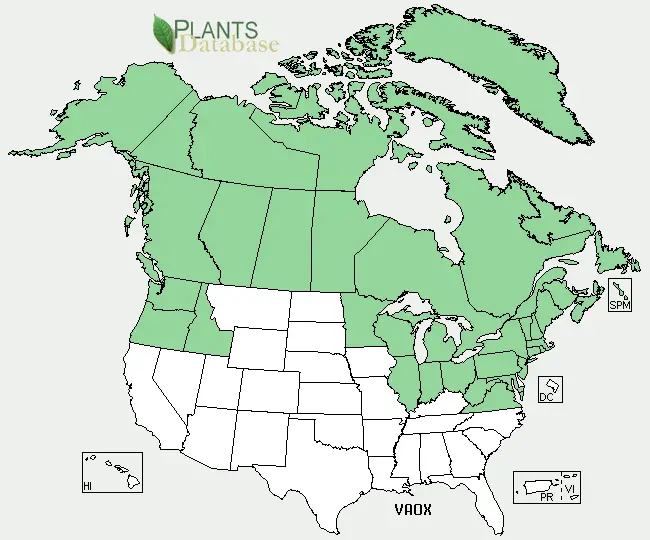
Common Cranberry or Northern Cranberry (Vaccinium oxycoccos or Oxycoccus palustris) range. Distribution map courtesy of U. S. Department of Agriculture (USDA Natural Resources Service) and used in accordance with their policies.
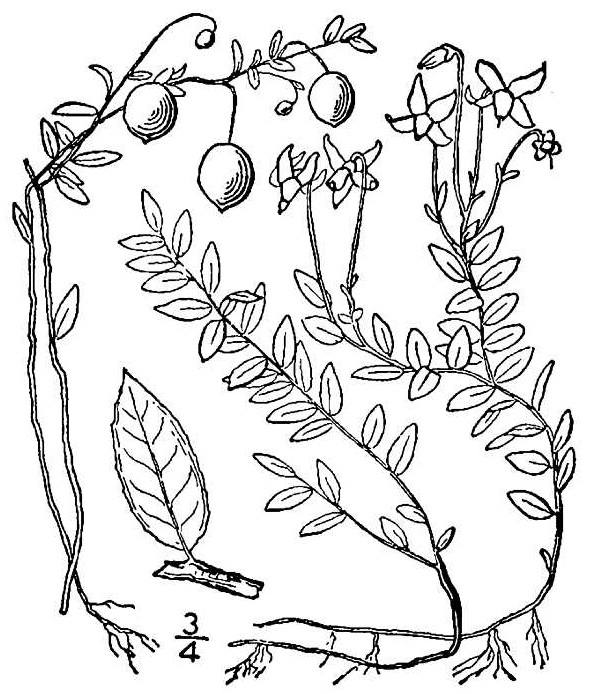
Common Cranberry drawing. (USDA-NRCS PLANTS Database / Britton, N.L., and A. Brown. 1913. An illustrated flora of the northern United States, Canada and the British Possessions. 3 vols. Charles Scribner's Sons, New York. Vol. 2: 704)
Common Cranberry or Northern Cranberry (Vaccinium oxycoccos or Oxycoccus palustris) in flower up close. (By: Qwert1234)
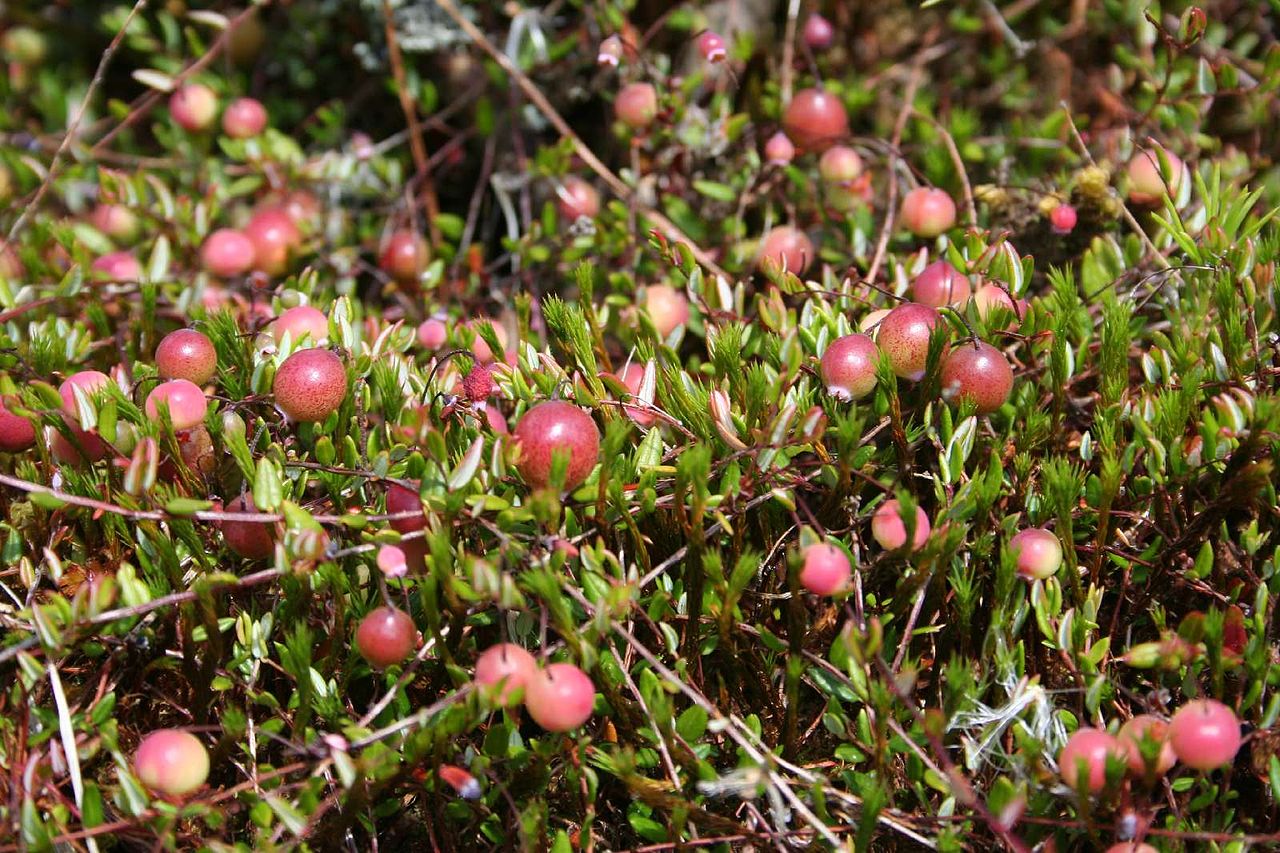
Common Cranberry or Northern Cranberry (Vaccinium oxycoccos or Oxycoccus palustris) ready to harvest. (By: B.Lezius CC BY-SA 3.0)
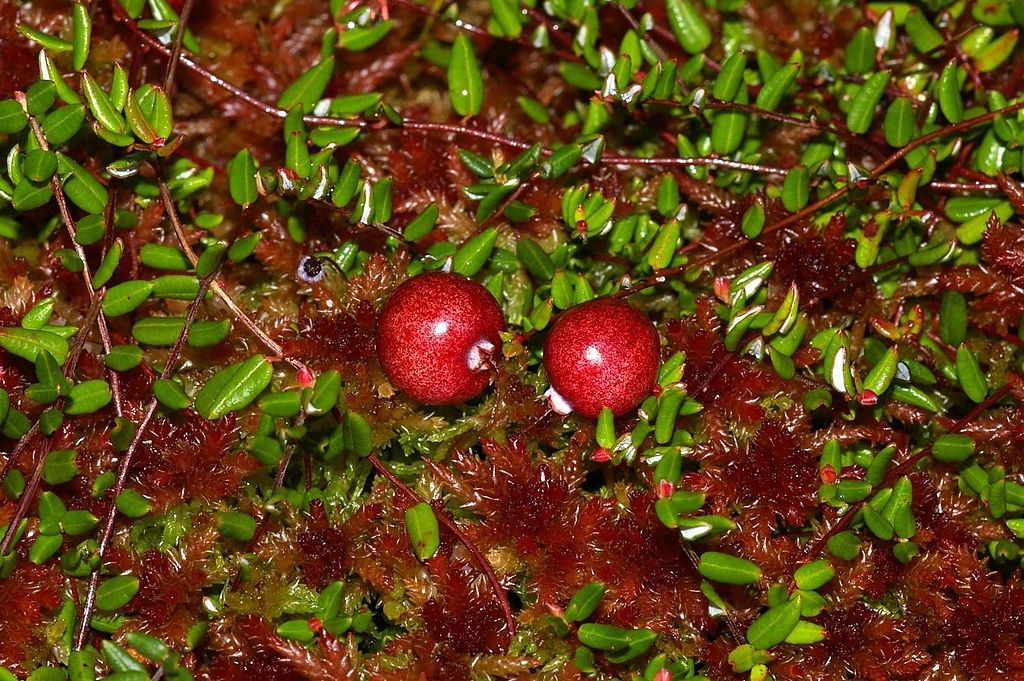
Common Cranberry or Northern Cranberry (Vaccinium oxycoccos or Oxycoccus palustris) up close. (By: Christian Fischer CC BY-SA 3.0)
Large Cranberry (Vaccinium macrocarpon or Oxycoccus macrocarpus). Known also as American Cranberry and Bearberry. This is the best one, and the one that is sold in stores frozen and fresh.
- USDA Plant Hardiness Zone: 2-7 (More information on hardiness zones).
- Soil pH: 4.0-5.5
- Plant Size: prostrate shrub up to 30 cm (12 inches) tall, forming a mat over an area
- Duration: Perennial
- Leaf Shape: Ovate
- Leaf Phyllotaxis (Arrangement) on branch: Alternate
- Leaf Size: 5-18 (1/5 to 9/32 inch) mm long
- Leaf Margin: Entire (smooth edged), often edges are curled back
- Leaf Notes: Glossy surface with leathery texture, bronze-gold hue in spring, turning green, often with red blotching (due to Exobasidium rostrupii infection - a sign the soil may be too rich in nitrogen), leaves stay on plant during the winter - an evergreen (an adaptation to living in low nutrient soils).
- Flowers: Pinkish-white flowers, four petals that point back, in clusters that come from the leaf axils, the center of the flower is tube shaped.
- Fruit: Ready to harvest mid to late October, pink to red, juicer than the smaller Common or Northern Cranberry,
- Bark: Twigs can be red, brown or grey in winter
- Habitat: Acidic, boggy soils with low nutrient levels
- Pictures on the web here (Google images) and here (Bing images).
- Interactive USDA distribution map and plant profile here.
- The Biota of North America Program (BONAP) distribution map here. BONAP map color key here.
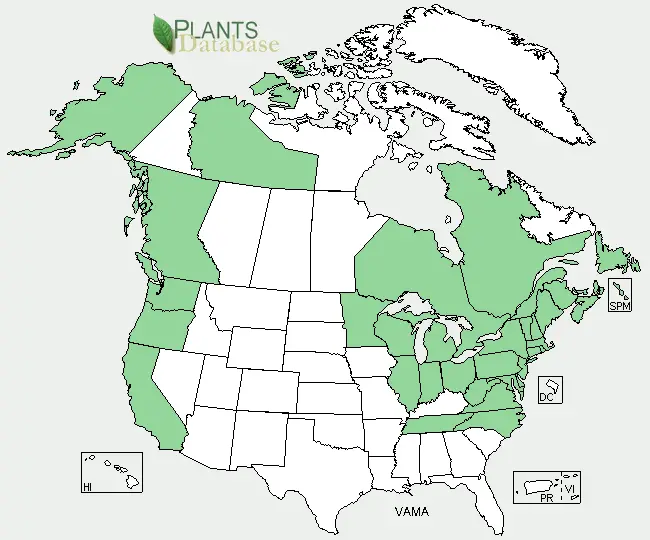
Large Cranberry (Vaccinium macrocarpon or Oxycoccus macrocarpus) range. Distribution map courtesy of U. S. Department of Agriculture (USDA Natural Resources Service) and used in accordance with their policies.
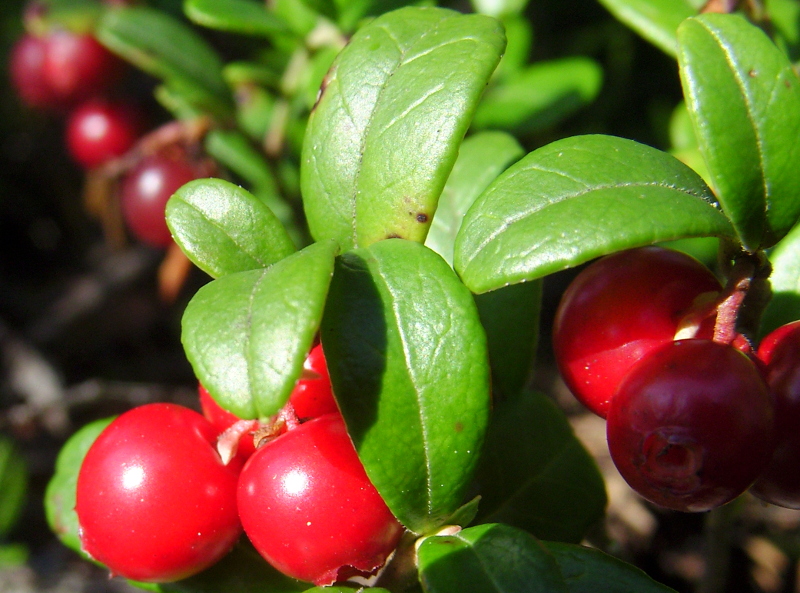
Large Cranberry (Vaccinium macrocarpon or Oxycoccus macrocarpus)
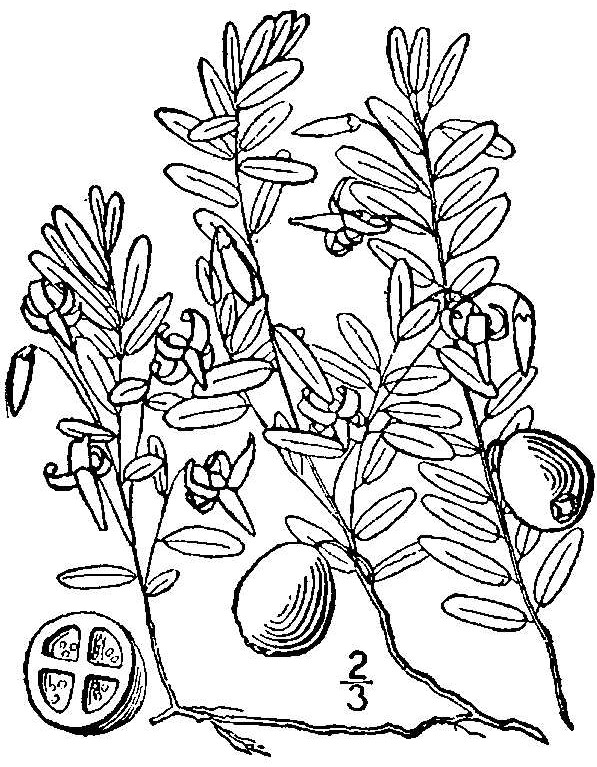
Large Cranberry drawing. (USDA-NRCS PLANTS Database / Britton, N.L., and A. Brown. 1913. An illustrated flora of the northern United States, Canada and the British Possessions. 3 vols. Charles Scribner's Sons, New York. Vol. 2: 705)
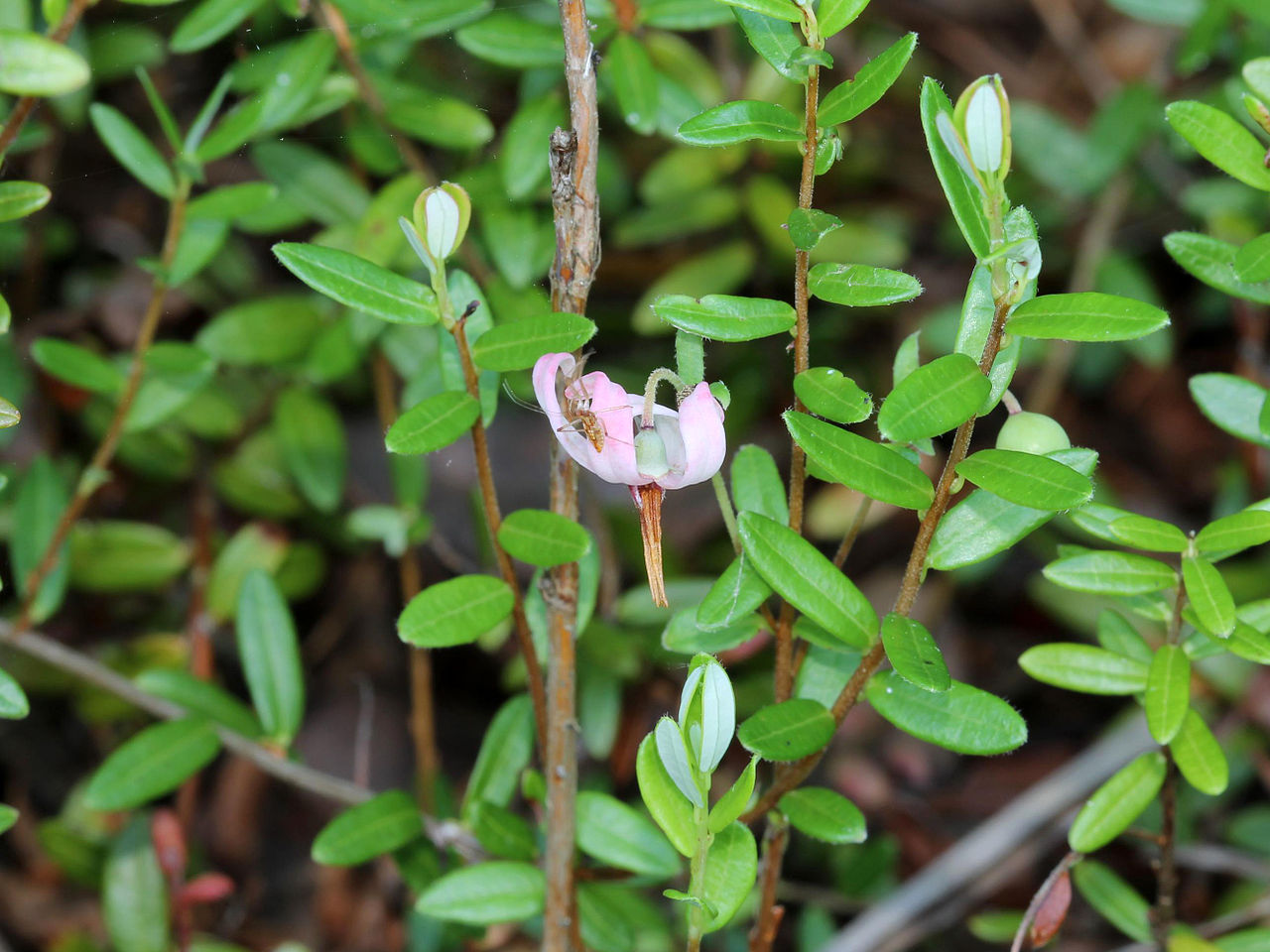
Large Cranberry (Vaccinium macrocarpon or Oxycoccus macrocarpus) in flower. (By: Rob Routledge, Sault College, Bugwood.org CC BY-SA 3.0)
Large Cranberry (Vaccinium macrocarpon or Oxycoccus macrocarpus) ready for harvest. (By: Sten Porse Creative Commons CC0 1.0 Universal Public Domain Dedication)
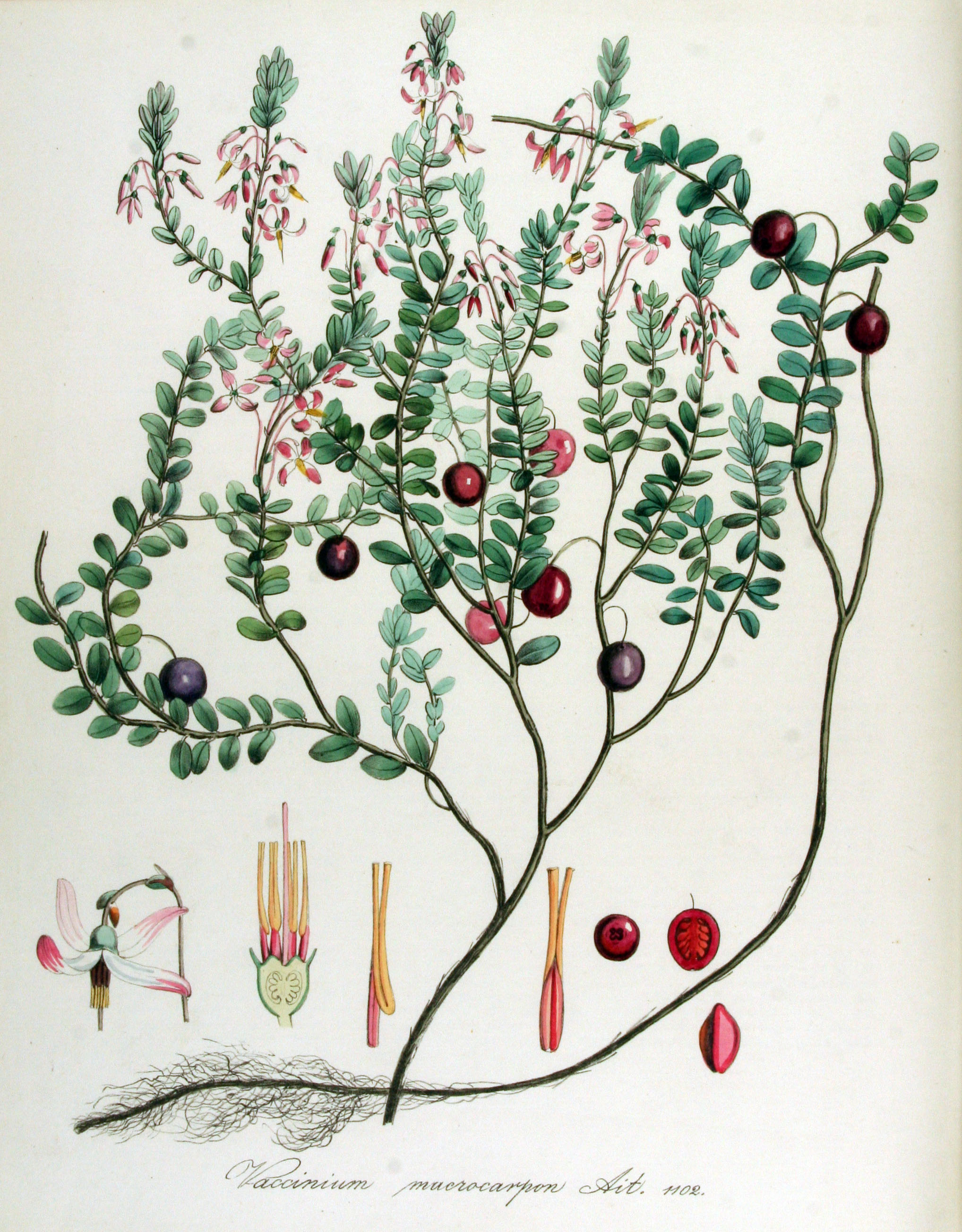
Large Cranberry (Vaccinium macrocarpon or Oxycoccus macrocarpus) illustration. (By: Flora Batava of Afbeelding en Beschrijving van Nederlandsche Gewassen, (1872) by Jan Kops)
Southern Mountain Cranberry (Vaccinium erythrocarpum or Oxycoccus erythrocarpus). Known also as the Dingleberry and Mountain Cranberry.
This one does not grow in wet areas, but prefers drier sites.
- USDA Plant Hardiness Zone: zone 6 and up (More information on hardiness zones).
- Soil pH: 4.5-6.0
- Plant Size: Shrub that grows to almost 2 meters (6 feet) high - forms thickets
- Duration: Lives many years
- Leaf Shape: Lanceolate
- Leaf Phyllotaxis (Arrangement) on branch: Alternate
- Leaf Size: 3-7 cm (1 1/5 to 2 3/4 inches) long, 1.5-3.5 cm (3/5 to 1 2/5 inches) wide
- Leaf Margin: fine, hair like Serrated (saw toothed edge)
- Leaf Notes: Deciduous, but leaves can persist into the winter
- Flowers: Pink with four curled or rolled back petals, long tube shape center
- Fruit: Ripe: late summer to early fall. Slightly transparent scarlet red to occasionally blackish red
- Bark: Twigs yellowish green to greyish green, can be almost 4 sided looking, but not as perfectly 4 sided as plants in the mint family
- Habitat: Highland woodlands openings or grassy areas with full sun, can withstand a little shading. Likes well drained acidic soils, often found on rocky ridges. Does not tolerate lime or limestone.
- Pictures on the web here (Google images) and here (Bing images).
- Interactive USDA distribution map and plant profile here.
- The Biota of North America Program (BONAP) distribution map here. BONAP map color key here.
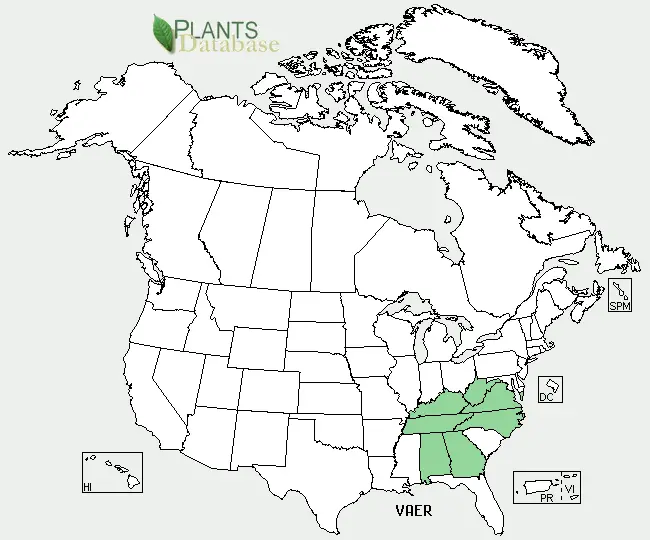
Southern Mountain Cranberry (Vaccinium erythrocarpum or Oxycoccus erythrocarpus) range. Distribution map courtesy of U. S. Department of Agriculture (USDA Natural Resources Service) and used in accordance with their policies.
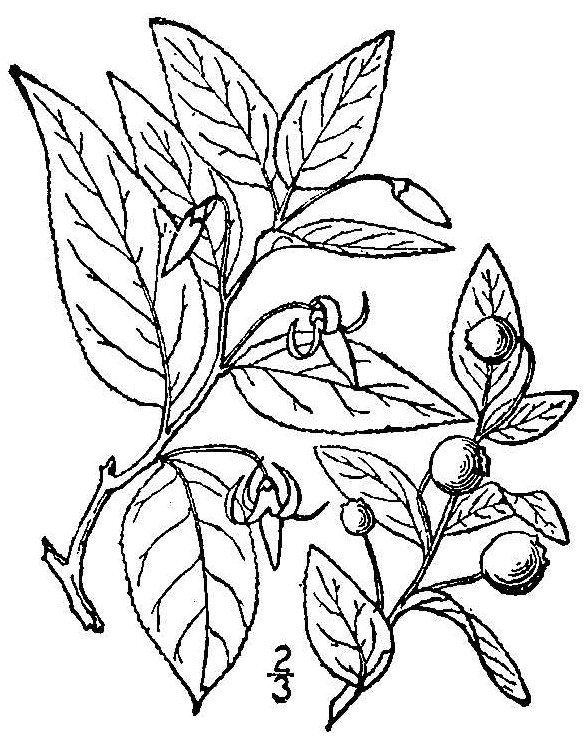
Southern Mountain Cranberry drawing. (USDA-NRCS PLANTS Database / Britton, N.L., and A. Brown. 1913. An illustrated flora of the northern United States, Canada and the British Possessions. 3 vols. Charles Scribner's Sons, New York. Vol. 2: 705)
Highbush Cranberry (Viburnum trilobum). Although called the Highbush Cranberry, this bush is not in the Vaccinium genus like the true Cranberries. It is a type of Viburnum. Go to the Viburnum section here for the Highbush Cranberry.
Search Wild Foods Home Garden & Nature's Restaurant Websites:
Share:
Why does this site have ads?
Originally the content in this site was a book that was sold through Amazon worldwide. However, I wanted the information to available to everyone free of charge, so I made this website. The ads on the site help cover the cost of maintaining the site and keeping it available.
Google + profile
